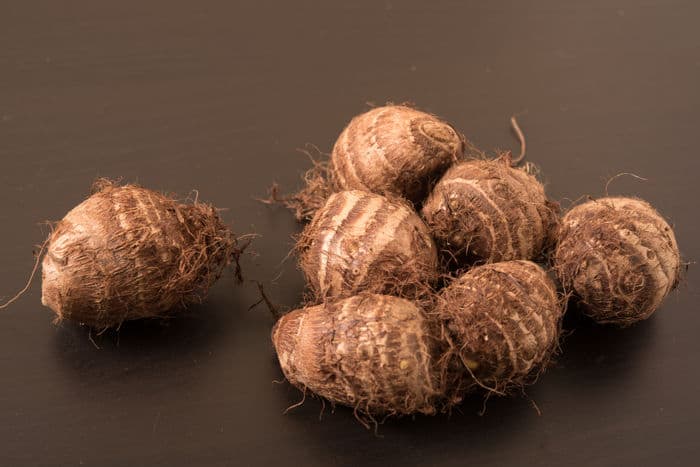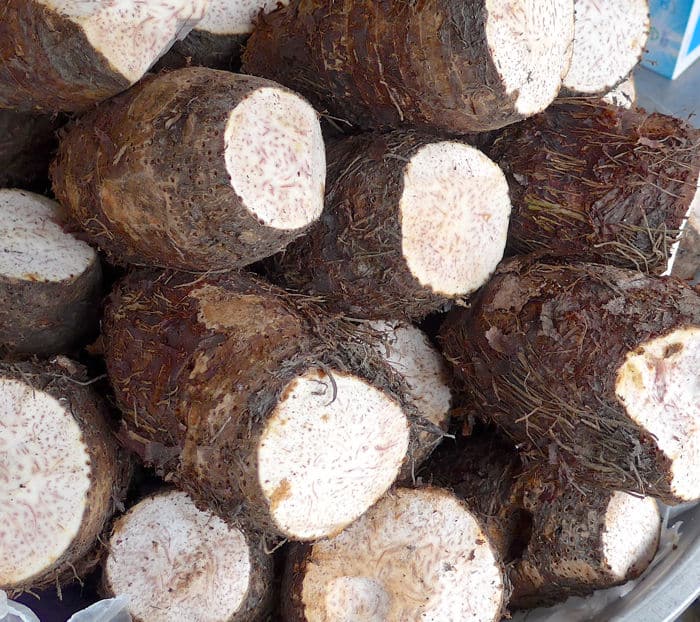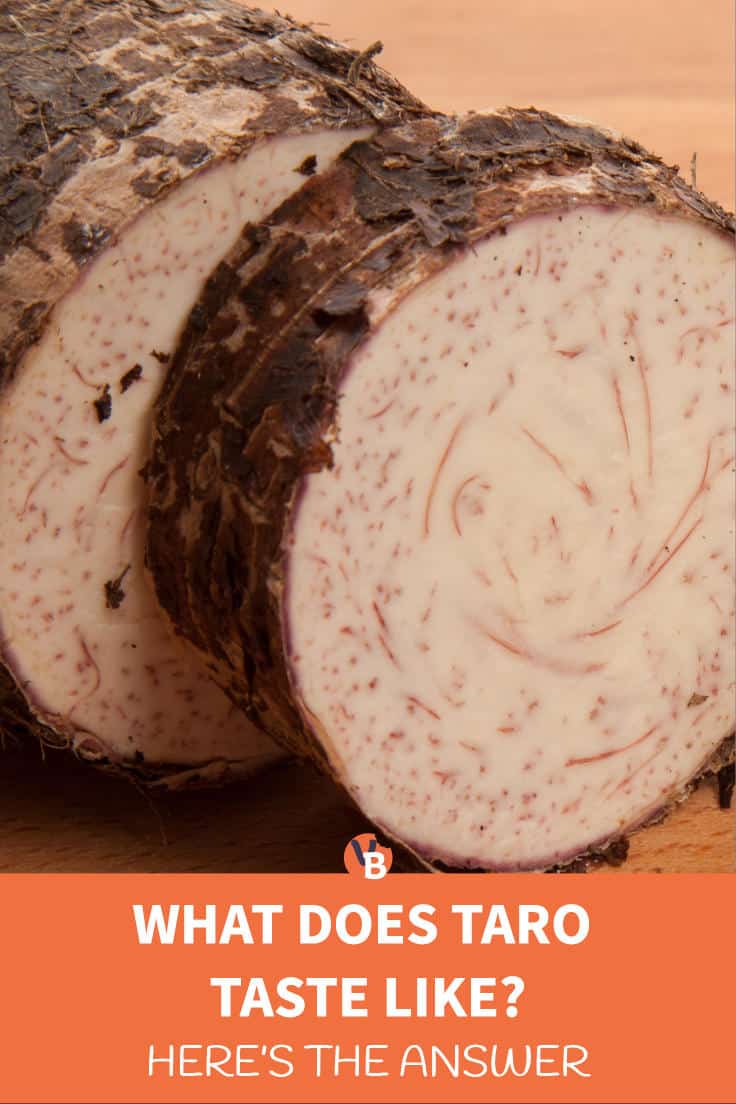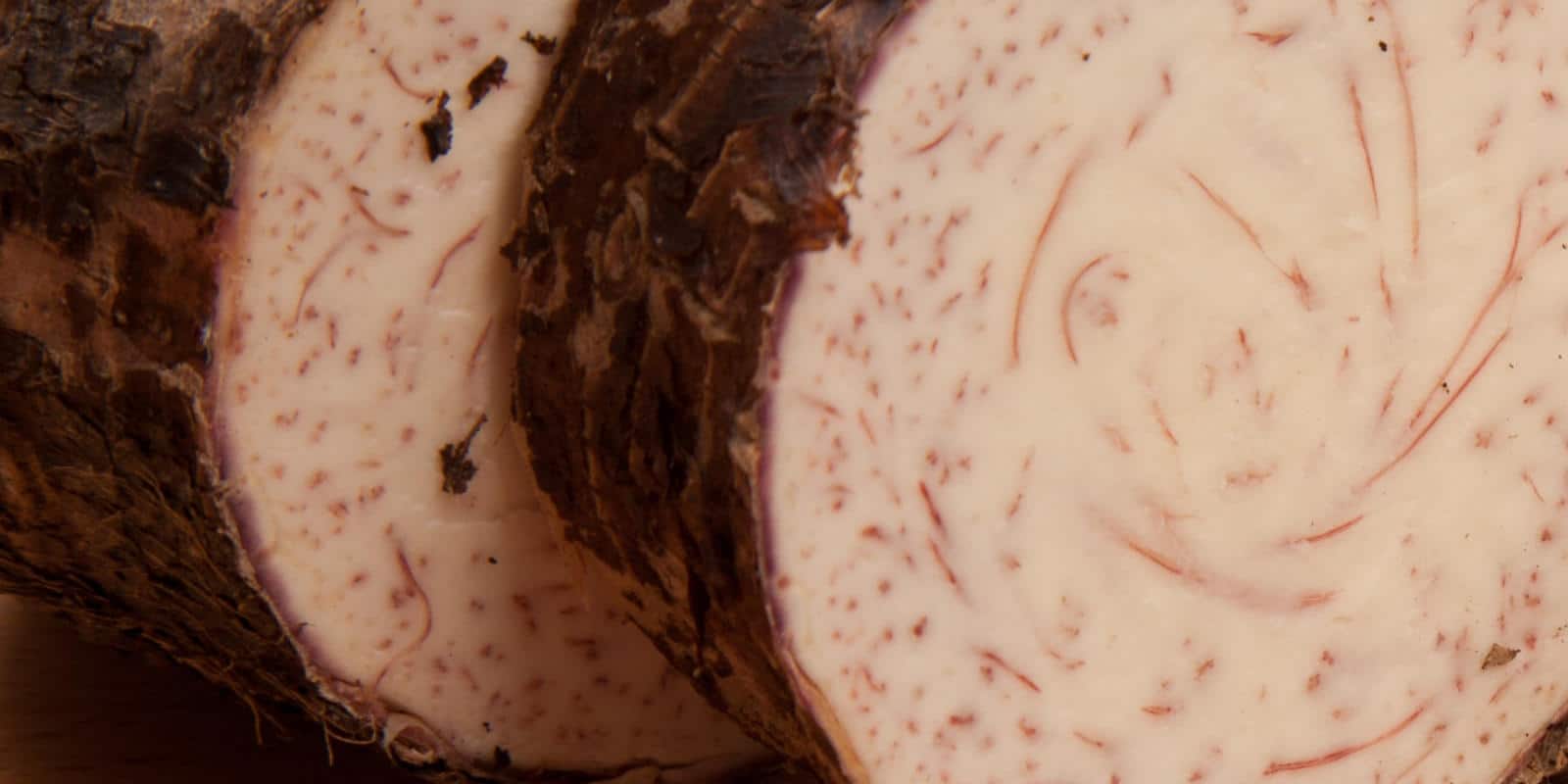If you’re anything like me, you didn’t pick up taro corms the first time you saw them, as you thought to yourself, “What is it, and what in the world would I do with it?”
Or, perhaps, you want to know what does taro taste like, in which case we’ll cover both aspects.
So, let’s take a closer look at this “tropical potato” and learn more!
Video Overview
What Is Taro?
During your grocery shopping in the produce aisle, chances are you’ve come across taro corm, the brown, root-looking stem vegetable part of the taro plant (Colocasia esculenta), which some also call the potato of the tropics.
Taro is native to India and Southeast Asia.
In many parts of the world, including the Caribbean, Hawaii, China, and Africa, taro corms are relied on as a staple food.
They’re also a popular alternative to roots and tubers like plain and sweet potatoes.
Appearance
Taro corms usually come in two distinct shapes:
- Small and round-shaped, similar to turnips
- Large, round and elongated, like yams

They’re brown and often have a hairy skin surface, leading the HuffPost to humorously call them “the potato’s hairy, kind of unfortunate-looking cousin.”

On the inside, taro corms are typically white, white with a purple tint, or cream-colored. You might even see purple flecks as well.
Taste and Texture
So, the big question, what do taro corms taste like? The thing is, I’ve found it depends on the variety and of course how you prepare them.
Some varieties have a plain or bland taste, while others have a more pronounced flavor.
According to Nutrition And You, cooked taro can have a nutty taste along the lines of water chestnut.
Sunset has described the taste as being similar to sweet potatoes.
When you get a flavorful bunch, I personally find taro has a starchy, yet mild, sweet, and very delicious taste. You’ll get the most sweetness out of the purple-tinted and smaller varieties.
If you happen to buy some bland or very mild-tasting taros, you’ll need to mix them with more flavorful ingredients to have an enjoyable meal.
The final texture will also depend on how you prepare your taro corms. But if you prepare it the same way you do other root vegetables, you’ll find the texture to be similar.
What Is Taro Used For?
Taro corms are a quite versatile ingredient and can be used in many ways.
For starters, taros can be steamed, boiled, roasted, and processed into gluten-free powder or flour for baking.
This also means you can substitute them in place of:
- plain and sweet potatoes
- yams
- rutabaga
- turnip
- and more
People have enjoyed taro’s delicious flavor in bubble tea beverages and puddings.
If you have some leftover cooked taro, you can actually mash it for use in a smoothie or homemade yogurt.
If you’re into gluten-free veggie noodles, and you have a spiralizer sitting around, you could make taro noodles.
Craving for something with more crunch? Taros can also be made into delicious chips.
Its versatility also extends to jellies, snacks and various desserts.
So, as you can see, you’re pretty much only limited by your creativity and imagination for what you can make with taro corms.
What Are the Health Benefits of Taro?
Maybe taros appealing nutritional profile will help entice you more to eat them!
They’re an excellent food source of dietary fiber, various minerals, B vitamins, and antioxidants.
These are some of the potential benefits:
Helps Reduce Diabetes Risk
Taros contain a healthy amount of fiber, in fact, 11% of our daily requirements per 100-gram serving. This fiber can help regulate the body’s insulin and blood glucose levels, as well as preventing those dreaded blood sugar spikes.
Improves Digestion and Bowel Regularity
Moreover, the high fiber content can help your digestive health and prevent constipation, bloating, gas and cramping by adding healthy bulk to your stools. This helps things “move through” more easily.
Protects Your Heart and Cardiovascular Health
Being a good source of potassium, taros support healthy heart rhythm and help keep your blood pressure levels regulated.
Protects Against Cramps
If you’re an athlete or participate in lengthy strenuous activities, not being hydrated or getting enough potassium through your diet can lead to muscle cramps. As you now know, taros supply a nice quantity of potassium so you won’t need to worry so much about this.
Supports Healthy Skin
Taro corms are also a good source of vitamins A and E, both of which are important nutrients for skin health. Taro helps keep your skin hydrated.
Protects Your Visual Health
Some of the antioxidants in taro include cryptoxanthin and beta-carotene, two crucial components that can help you maintain overall eye health and reduce your risk for problems like macular degeneration. So, if you’re out of carrots, taros can save the day!
Promotes Better Immunity
With a variety of minerals that play a key part in immune health, along with also supplying some high-antioxidant nutrients like vitamin C and E, which protect against free radical damage, having taros as a staple in your diet can play a role in boosting your immune system.
Supports Bone Health
Eating taros regularly will also boost your intake of calcium and magnesium, two very important minerals which play a key role in supporting strong bones. This helps protect against osteoporosis and overall bone fragility.
Availability
Like many other common root vegetables and tubers, taro corms are available year-round. So, if your local produce market or grocery store has them, you won’t need to be concerned about low stock.
Depending on storage conditions and temperature, you can store taro for 2-3 weeks at 68°F (20°C), or up to 5 months at a cooler temperature.
According to 5+ A Day, you should store taro in a cool, dark, and ventilated place and avoid refrigeration as it can affect the overall flavor of your taro.
If you want to boil taro, you should go for the smaller ones as they are moister, so better for this type of cooking.
Otherwise, large corms are great especially if you intend on making large portions to feed many people.
Make sure the larger ones are firm and heavy while avoiding any taros which have dry or soft patches.
How to Prepare and Cook Taro
One thing I, unfortunately, learned the hard way is that raw taro corms need to be handled with care.
If you’re prone to skin irritations, chances are physical contact with taro skin will cause you rashes, itchiness, or similar skin issues.
Therefore, you should clean the skin while wearing gloves. What you want to make will determine whether you should leave on or peel off the skin using a vegetable peeler.
Remove any rotten spots you may find. And if you see any sprouts, remove those as well since they’re considered toxic.
Taro needs to be cooked thoroughly, so some people choose to bring taro to an initial boil, drain off the water, then boil again or steam until it’s ready. This reduces any chance of throat irritations when you eat the taro.
What You Need to Know
The most notable problem with taro is its calcium oxalate content, which increases the risk of kidney stones and gout symptoms and is responsible for the itchy or numb feeling you might experience if you don’t cook it thoroughly enough.
A common tip I came across, is to steep your taro in water overnight to reduce the calcium oxalate content. Consider it a small but worthwhile inconvenience.
Wrapping Up
So now you’ve learned about taro and what it tastes like. It’s a nutritious and generally affordable alternative to the commonly known staple tubers.
They’re delicious and, compared to potatoes, even healthier and slightly more versatile.
Always remember to prepare your taro properly to avoid any issues.
If you do try them, please let me know what you think!








